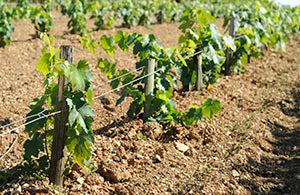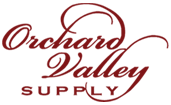Starting Your Own Vineyard

Orchard Valley Supply provides the best materials one would need when building a vineyard. Whether you're adding a couple of rows of grapes in your backyard or you’re looking to establish an acre or more, we have all the top brands in the industry that you will need to get started. We appreciate the opportunity and the small part we play in making your grapes the best they can be.
Before you begin to buy the necessary products to build your Vineyard Trellis and help maintain the growth and production of your grapes, it is essential to ask yourself these questions that will ultimately shape your vineyard. Remember each vineyard is going to be site specific. If you have questions for us, we will do our best to answer them. However, we always recommend either talking to a local Agriculture Extension Agent or other local growers to get a real feel for what might impact your vineyard.
Questions to ask before you build your vineyard:
- Have I had the soil evaluated for available nutrients and potential issues?
There isn’t anything high-tech about this. Grab a shovel and dig a hole (about three feet deep). Scrape the soil off the side of the hole and put it in a large Ziploc bag. Be sure to obtain two samples; one from a depth of 1-12 inches and the second from 24 inches and below. Reach out to your local Agriculture Extension Agent for a laboratory that can evaluate your soil sample for wine grapes. A neutral pH of around 7 remains optimal along with well-drained soil.
- How will local weather impact my vines?
Ideally, you want between 150 to 200 frost-free days to produce mature vinifera fruit. The key is to find out what your neighbors are planting and what vines produce the best wines. If you cannot find local winegrape growers, call a few nurseries and ask about the type of grapevines that might do best in your area.
- What pest challenges will I face?
Again, this is another excellent opportunity to reach out to your local Agriculture Extension Agent. Ask them the following questions: What types of pests currently reside in your area? What insects are likely to feed on your vines? Do any of them carry a disease, and if so, how can you protect your vines from infection? In addition to insects, your fruit might attract wild pigs, deer, rabbits or flocks of birds. We have found fencing, netting or or both to be good wildlife control options in addition to noise, scent, taste and scare devices to discourage animals from destroying your crop.
- How are the vines going to be irrigated?
 Applying water to your vines either through the ground or by “drip irrigation” is much more efficient than by sprinkler. Try to keep water off the fruit and vines; otherwise, you might have problems with rot and mildew. Wine grapes like just enough water, so be careful not to overwater them. In general, early watering before May 1st can produce leaves but no grapes.
Applying water to your vines either through the ground or by “drip irrigation” is much more efficient than by sprinkler. Try to keep water off the fruit and vines; otherwise, you might have problems with rot and mildew. Wine grapes like just enough water, so be careful not to overwater them. In general, early watering before May 1st can produce leaves but no grapes.
- How much crop do I need for my winemaking?
There are a lot of factors which go into harvesting your grapes, and each one of those may have an impact on the amount of wine you’re able to yield from your fruit. You can apply these simple ratios to determine how many vines you will need in order to produce a certain amount of wine.
- 20lbs. of fresh fruit = 1 gallon of homemade wine
- 250 vines = 60 gallons of wine (assuming 5lbs. of fresh fruit per plant)
- How am I going to trellis my vines?
Excellent question! There are several different options you have when selecting the type of trellis system you will use. Many of the factors involved when choosing a trellising option are site specific and relate to personal preference and cost as almost anything.
In most cases there are two options of trellis posts: wood and metal (some people might use a combination of the two). Wood posts have been in use for a much longer time in vineyards than metal posts; however, metal line posts have been in use for decades in Californian and French vineyards.
- What comes first? Planting my vines or building a trellis?
The general rule of thumb is that it will take three years for a young vine to mature and produce the fruit you will need to harvest for winemaking. Often, you can plant your vines before building your trellis and begin the training process. Orchard Valley Supply has a variety of training stakes including bamboo, fiberglass, and metal to help train your vines vertically.
- How am I going to position my vineyard?
Vineyard positioning questions are always tough since we are not able to be there and see the exact parameters you are working with. Because each developing vineyard is site-specific, we recommend reaching out to your local Agriculture Extension Agent or making an appointment with a consultant to meet your unique needs.
How to Build Your Trellis System
Your trellis system serves as the framework for training and supporting the vines. It is of great importance that you devote a good amount of time when considering the best system for your situation. Ideally, what you want in a trellis system is for it to be able to support large crops and heavy winds and to last 15 years or more with routine maintenance.
The major components of a trellis are:
Posts: Wood, Metal (steel preferred) and other materials.
- Orchard Valley Supply sources the best wood available from across the country. We have access to CCA treated Southern Yellow Pine, Red Pine, and Lodgepole Pine.
- Our steel posts are American made, right here in the United States, not from overseas.
- Other trellising examples are the Open Lyre system and use of trellis-posts.
Putting in a trellis can be difficult and time-consuming. Depending on your available resources, you may find that you have to drive posts in by hand or in some instances when putting in a large number of posts you might want to rent a hydraulic drive that will make quick work of those posts. To make things a little easier, we offer several options to help drive both posts and anchors into the ground more efficiently. These include: drive caps, post drive, earth anchor adaptor, ground anchor strike plate, ground anchor drive tool and the stony ground anchor tool set.
Strong End Post Design:
- Anchored: ideal for rows less than 600 feet (earth anchor, tie-back post, end post anchor, Gripple® ground anchor, stony ground anchor).
- Braced: H-brace or slant brace for rows over 600 feet.
High-Tensile Galvanized Steel Wire:
- Depending upon the style of your trellis system you may need to have 3 to 4 and sometimes as many as six different lines of wire. Orchard Valley Supply offers rolls of wire from 500’ to 4,000’ in 12.5 gauge.
- Additional hardware you may need to use with wire include springs, cross arms, fasteners, tignteners, and wire splicers.
